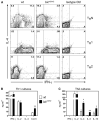Requirement of bic/microRNA-155 for normal immune function
- PMID: 17463290
- PMCID: PMC2610435
- DOI: 10.1126/science.1139253
Requirement of bic/microRNA-155 for normal immune function
Abstract
MicroRNAs are a class of small RNAs that are increasingly being recognized as important regulators of gene expression. Although hundreds of microRNAs are present in the mammalian genome, genetic studies addressing their physiological roles are at an early stage. We have shown that mice deficient for bic/microRNA-155 are immunodeficient and display increased lung airway remodeling. We demonstrate a requirement of bic/microRNA-155 for the function of B and T lymphocytes and dendritic cells. Transcriptome analysis of bic/microRNA-155-deficient CD4+ T cells identified a wide spectrum of microRNA-155-regulated genes, including cytokines, chemokines, and transcription factors. Our work suggests that bic/microRNA-155 plays a key role in the homeostasis and function of the immune system.
Figures




Comment in
-
Genetics. Erasing microRNAs reveals their powerful punch.Science. 2007 Apr 27;316(5824):530. doi: 10.1126/science.316.5824.530. Science. 2007. PMID: 17463259 No abstract available.
References
Publication types
MeSH terms
Substances
Grants and funding
LinkOut - more resources
Full Text Sources
Other Literature Sources
Medical
Molecular Biology Databases
Research Materials

